PVC pipes for external sewerage: types, sizes, advantages and disadvantages
Pipes are integral structural elements of the sewer system.Since external sewerage pipes must withstand both static and dynamic loads, special requirements are placed on them.
PVC pipes for external sewerage cope well with the task. The main thing before purchasing is to correctly select the optimal standard size and take into account a number of nuances during the installation process. This is exactly what we will talk about in our article. We will separately highlight the main advantages and disadvantages of PVC pipes and indicate the main characteristics that distinguish them from other polymer pipes.
We will also describe the features of connecting pipes to each other when assembling a sewer pipeline and pay attention to the laying rules.
The content of the article:
What are PVC pipes made of?
When installing both above-ground and underground sewer systems, polyvinyl chloride pipes are rightfully considered the leaders among similar polymer products.
The basis for the manufacture of polyvinyl chloride cylindrical products is the thermoplastic of the same name. It is advantageous in that it retains its shape after heat treatment and extrusion.
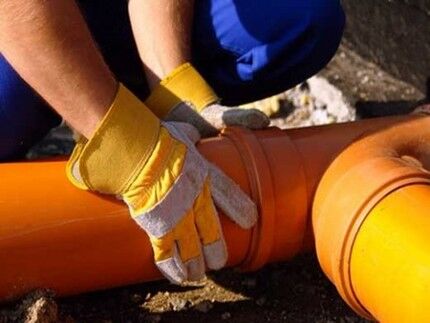
The two main components of polyvinyl chloride are ethylene and stabilized chlorine.
To improve the performance parameters of products during the production process, various types of additives are added to thermoplastic compositions.
Advantages and disadvantages of PVC products
Polyvinyl chloride, after being processed under high pressure at the outlet, forms a super-strong composite compound. Therefore, products made from this polymer have many advantages.
These include:
- Affordable price. Compared to concrete and cast iron Compared to analogues, the price of polymer products is relatively low, which makes them accessible to any consumer.
- High performance parameters. Corrosion does not form on the walls of polymer pipes. The products are resistant to aggressive environments. Thanks to the smooth inner surface, deposits and build-up do not form on them.
- Light product weight at a fairly high level of strength.
- Easy to install, which does not involve the use of special equipment.
- Wide variety of mounting elements. This greatly simplifies the design of branched, complex pipelines.
Polymer pipes are frost-resistant. So, when completely frozen, provided that there is no water in the pipeline, it does not even crack. The service life of polymer cylindrical products is over half a century
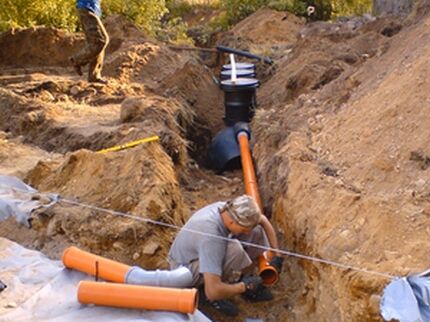
High levels of corrosion resistance give the go-ahead for the installation of polymer pipes underground. And this factor is key, since 90% of sewer pipelines run there.
With strict adherence to installation technology, even when the level of groundwater changes, polymer structures are not subject to displacement in the area of the connecting points, thereby minimizing the risk of depressurization of the system.
The only drawback of polymer pipes is their low resistance to UV rays and temperature restrictions from -10 ° C to +65 ° C. Direct contact with UV rays reduces the performance of products. In this regard, they lose to their steel and cast iron counterparts, which cannot be harmed by ultraviolet radiation.
Main types and sizes
Depending on the conditions of use, PVC pipes are produced in three versions, which correspond to the main standard sizes:
- SDR51; SN-2; series S25 – lightweight products are laid under the sidewalk, green area and in places where traffic loads are not expected.
- SDR41; SN-4; series S20 – medium-type products are chosen for installation in places where traffic is not so high.
- SDR34; SN-8; row S16.7 – heavy-duty products are chosen for installation in industrial areas and places with heavy traffic flow.
Pipes used for laying external pipelines are one-, two- and three-layer. In the latter embodiment, the inner layers of the product are made of foam material with a porous structure, which is obtained by recycling. And the top layer is made of primary unplasticized PVC.
The most widespread when laying outdoors are two-layer corrugated pipes. The outer layer of such products has a corrugated surface with stiffeners. Thanks to this, the corrugation acquires increased strength.

Both walls of profiled products are manufactured simultaneously. Due to the fact that they are connected using the “hot” method, the finished cylindrical products represent an integral structure. The cavities formed between the inner and outer walls lighten the weight of the structure, and the wavy wall on the outer side provides the necessary annular rigidity.
If we take the ring stiffness class as the basis for the classification of polymer products, then PVC pipes come in three types:
- "L" - lightweight pipes for laying in ditches, the depth of which does not exceed 0.8-2.0 meters.
- "N" — medium-hard products are designed for laying to a depth of 2-6 meters.
- "S" - rigid with maximum wall thickness, which can be laid in trenches up to 8 meters deep.
The ring stiffness parameter of products is indicated by the abbreviation "SN". It is a significant value because it determines the initial deformation during laying and lateral support.

In systems that provide for forced drainage of wastewater, where pump equipment, install PVC pressure pipes. The basis for their production is unplasticized polyvinyl chloride PVC-U, which is famous for its highest performance characteristics.
The main difference between pressure pipes is that they are able to withstand significant loads on the walls.There are three types of pressure pipes on sale that can withstand pressures of 6, 10 and 12.5 kg/cm2.
In gravity-type sewer systems, wastewater moves under the influence of gravity. To construct such systems, ordinary PVC pipes are used, created on the basis of a simpler PVC polymer. The temperature range of these products is from 0 °C to +45 °C.
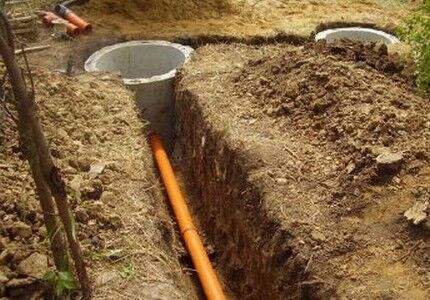
The size range of PVC pipes for external sewerage is also quite wide:
- 110 mm – products with a minimum diameter are intended for the disposal of domestic wastewater in suburban construction.
- 315 mm – pipes of this size are used when it is necessary to build a common sewer system connecting several houses.
- 630 mm – pipes of maximum diameter are used for the construction of the main village sewerage main.
They produce cylindrical products in sections of 500/1000/2000/3000/…6000 mm. Some standard sizes can also be produced in twelve-meter lengths. More details about characteristics of PVC pipes we talked about in this article.
Criteria for choosing wisely
When choosing sewer pipes, they are guided by only two parameters: wall thickness and the internal diameter of the product. The mechanical strength of the product largely depends on the thickness of the walls.
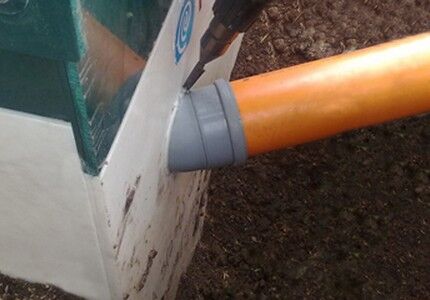
For internal sewerage, PVC pipes painted gray are used. When installing gravity systems, the wall thickness of such products must be at least 1.8 mm.
For external laying, which requires more severe conditions, choose products in orange and yellow shades. In such products, each size has its own wall thickness.
As an example, we give the correspondence of parameters for pipes D 200 mm:
- SN2 – for light conditions with a pipeline depth within 2 meters, choose pipes with a wall thickness of 3.9 mm.
- SN4 – for average conditions of rigidity with a pipe laying depth of around 4 meters, products with a wall thickness of 4.9 mm are selected.
- SN6 – for difficult conditions with a pipeline depth of up to 6 meters, pipes with a wall thickness of 5.9 mm are used.
In addition to orange-colored products, polymer pipes painted brick-red can be used for laying external sewerage. Which sewer pipes do you prefer? It is this question that we will detail discussed here.

Corrugated pipes intended for external sewerage have dimensions in outer diameter ranging from 160 to 630 mm, and in nominal diameter from 139 to 542 mm. They are produced in the form of six-meter lengths. Product ring stiffness parameter – SN8 or SN16.
The difference between PVC products and other polymer pipes
Polyvinyl chloride is far from the only polymer used in the manufacture of pipes.
Along with it, the following types of plastic are used:
- RE polyethylene - plastic is used to create pipes intended for transporting cold water.
- RE-S cross-linked polyethylene - polymer has temperature limits of about +95 ° C. Therefore, it is used for both cold and hot water. It is famous for its resistance to mechanical stress and UV radiation.
- RPE polypropylene – characterized by good chemical and mechanical resistance.
- PVDF – semi-crystalline thermoplastic, which is famous for its resistance to chemical environments. Mainly used in the pharmaceutical industry for transporting drugs.
- PB polybutylene – cross-linked polyethylene. It is produced in small quantities because it is not particularly durable.
Many of the listed types of plastic pipes can compete with PVC products, but in terms of the range of advantages and price-quality ratio, PVC pipes have no competitors.
Features of installation of external PVC sewerage
Pipes made of polymer are famous for their ease of installation. To create a pipeline based on PVC pipes and fittings, no special tools are required. And even a novice master can perform the work of assembling and laying the pipeline.
Methods of connecting products
PVC sewer pipes can be connected in one of two ways:
- Adhesive – involves connecting elements by applying a special adhesive composition to the fittings.
- Bell-shaped – involves joining elements by deepening straight sections into sockets pre-treated with sealing compounds.
The adhesive connection, also known as “cold welding,” allows for 100% tightness.
When using the adhesive installation method, compositions are used that are able to “weld” elements adjacent to each other at the molecular level.
When joining pipes with shaped elements, one end of the pipe is coated with silicone grease and inserted into the socket until it stops. The joining of elements is done manually.
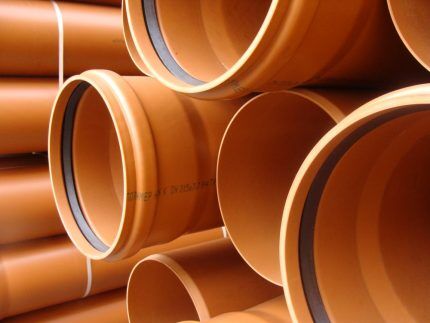
Basic installation rules
The key to the uninterrupted functioning of the sewer system is strict adherence to installation technology. And laying polymer pipes is no exception.
When constructing an external PVC pipeline, it is important to follow a number of basic rules:
- A shock-absorbing “cushion” should be laid at the bottom of the dug trenches. Crushed stone-sand filling will help protect pipes from destruction that may occur due to seasonal soil movements.
- Pipes need to be laid downhill towards the receiving manifold. The slope angle largely depends on the diameter of the pipes and can vary from 2 to 15%.
- If it is necessary to change the direction of the collector, bends of 15-30° are used.
- When laying an external pipeline, inspection hatches are installed every 15 meters.
When backfilling a pipeline laid in a ditch, the soil is compacted only from the sides. There is no need to compact directly above the highway.
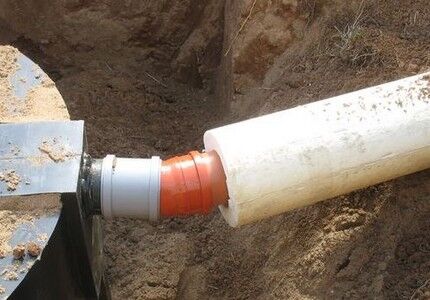
If it is impossible to bury polymer pipes to the required depth, they should be insulate. This is especially true for products made from non-polymerized polyvinyl chloride, since they become brittle in the cold.
An important point: after insulating the pipeline, you need to re-measure the angle of inclination and, if it meets the standard, proceed with the final backfilling with earth.
In addition to choosing high-quality pipes for external sewerage and their correct installation, it is equally important to select the best pipes for the installation internal sewer system and install in accordance with standards and regulations.
Conclusions and useful video on the topic
Options for sewer pipes and fittings:
Subtleties and nuances of sewer pipeline installation:
With a competent approach to the selection of products and compliance with installation technology, the service life of the pipeline will be commensurate with the “life” of the house itself.
Do you have an external sewer system made of PVC pipes and would you like to share your experience in installing and operating the system? Or maybe you noticed an error in the material presented or want to supplement our article with valuable comments and recommendations? Write your comments, ask questions, share your opinion in the block below.




I live in a private house, I did the sewerage myself. I dug a hole and laid out a dozen unnecessary truck tires of the same size. I dug a ditch half a meter deep. I laid a PVC pipe with a diameter of 100 millimeters, having previously wrapped it with insulation, put roofing felt on top and buried it. And I inserted another one into it, with a smaller diameter of 50 mm. Maybe I did too much, but the design turned out to be simple and has been in use for seven years now.
The main disadvantage of PVC pipes is that they cannot be used at low temperatures; already at -15 degrees they begin to freeze. In our latitudes, such temperatures are far from uncommon, so we also have to deal with the insulation of PVC pipes. But this is not the only disadvantage - there are still difficulties in connecting plastic pipes to metal ones. Often you have to connect through an American cable or other adapters, which is not always convenient. On the other hand, now plastic is replacing metal everywhere and there is no escape from this.
So maybe in this case it is better to use PP pipes? They are a little more expensive, but the operating temperature range is much wider. How are such pipes generally insulated, or is a heating cable more practical for a private home?
As for the characteristics of PP pipes relative to PVC, the former have superiority, taking into account such qualities as:
1. Maximum temperature threshold;
2. Tensile strength limit, MPa;
3. Bending resistance limit, MPa.
For clarity, I will attach a table, but frost resistance is better for PE pipes. Regarding insulation, you need to use special insulation made of mineral wool, polyurethane foam, polyethylene foam or penoizol. But it is better to lay the external sewer pipe below the soil freezing mark, then insulation will not be needed.